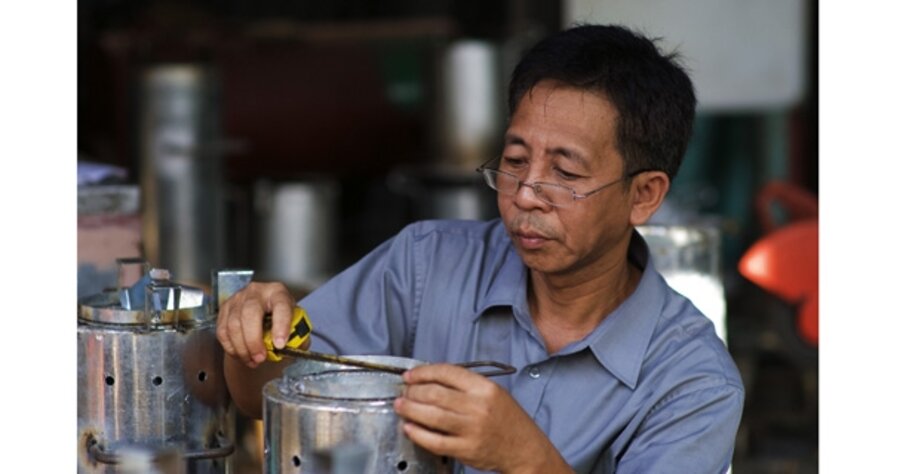Rice-powered stove ignites new hope for poor farmers
Alexis Belonio’s obsession with rice husks began in 2003, when rising fuel prices and heavy dependence on foreign oil slammed his native Philippines with an energy crunch.
“I saw rice mills throw husks into the rivers,” says the agricultural engineer. “I started thinking about using them as fuel.”
Mr. Belonio was already an accomplished inventor, having designed over 30 devices ranging from paddy dryers to water pumps for poor Filipino farmers. So his thinking led him to the cooking stove, an item fraught with expense and danger in the developing world.
More than a third of the world’s population can’t afford propane or other petroleum-based cooking fuels, relying instead on biomass such as wood or charcoal. Most biomass is burned in inefficient stoves that emit soot, smoke, and toxic fumes.
Belonio envisioned a safer, cleaner, and less-expensive way to cook. Working largely in isolation and with little funding, he turned rice husks – an inedible byproduct of milling rice for food – into a bright blue flame.
Inventing the impossible
Turning rice husks into fuel isn’t a new idea: Several cooking stoves invented for the developing world, such as the Lo Trau (Vietnamese for “rice husk stove”), can use the agricultural waste. But husks are messy. They tend to make a smoky, unstable fire and leave a tar-like residue, says Kirk R. Smith, an environmental health scientist at the University of California, Berkeley, who specializes in indoor air quality and frequently tests cooking stoves.
Burning husks cleanly enough to rival a propane or butane stove at low cost was deemed impossible by many stove developers.
“We were sure this couldn’t be done,” says Paul Anderson, a geographer who has spent the past five years since retiring from Illinois State University designing stoves for the developing world.
Mr. Anderson worked on his designs with Tom Reed, a former Massachusetts Institute of Technology chemist. Mr. Reed invented the top-lit updraft (T-LUD) biomass stove, one of a class of stoves that can “gasify” its fuel. In gasifier stoves, biomass burns until only charcoal and burnable gases remain; the gases are separated and ignited, producing a smokeless blue flame like that of a natural gas stove, leaving only charcoal behind.
In traditional wood fires, these two processes happen together, creating the familiar yellow, smoky flames. Separating the stages makes for a cleaner, more controlled burn that has made the technology popular worldwide.
Reed and Anderson burned wood in their T-LUD stoves, but neither succeeded in gasifying finer agricultural waste. Then, after seeing a Reed T-LUD stove demonstration at a conference in Thailand, Belonio started imagining a husk gasifier.
“Nobody told Alexis Belonio you weren’t supposed to do this with rice husks,” says Anderson. “So he just went off and did it.”
The secret to Belonio’s success is good engineering and adequate air, Anderson explains. His design includes a small electric or battery-powered fan that circulates air through the husks, enabling them to burn more efficiently.
The fan and fuel sit in the bottom of an iron and steel tube more than a yard long. The tube traps the gases the husks release when they’re lit – mostly hydrogen, methane, and carbon monoxide – and combusts them at the burner on top of the tube. Users can raise or lower the flame by changing the fan speed. When the husks have burned, the remaining charcoal can serve as a fertilizer for crops.
“This technology is superior to virtually everything else out there,” says Anderson. “Belonio stimulated me and others to go back and look again at rice husks and other fine materials.”
Belonio’s stove does have its drawbacks: It requires access to batteries or the electrical grid, and its $20 price tag is too steep for the poorest potential users.
“[The cooker] isn’t exciting until it’s affecting the lives of many people and you can prove that,” says Mr. Smith, noting that Belonio’s stove has not yet seen widespread testing in the field.
Abundant resources
To millions of people in the world’s rice-rich regions, the stove could offer a cleaner, cheaper cooking option that recycles an existing waste with little impact on the environment.
“In Myanmar, I recently visited a mid-size rice mill that was using rice husks to power the mill, produce electricity for the house, and do the cooking on four larger stoves,” says Martin Gummert, a specialist for the International Rice Research Institute. “There were still husks left.”
Mr. Gummert estimates that the world’s 645 million-ton rice harvest in 2007 generated 129 million tons of rice husks. This leaves an abundance of fuel for Belonio’s stoves, which can wring about 20 minutes of cooking time from one pound of husks.
Because rice husks are cheap and widely available, running the Belonio stove costs only 20 cents a day in the Philippines – most of which is the cost of running the fan. That can save farmers more than $150 a year on fuel compared with regular stoves.
The stove’s promise hasn’t gone unnoticed. Last month, watchmaker Rolex named Belonio as one of its 10 exemplary innovators. Belonio says he plans to use the $50,000 prize to build a stove demonstration and research center in Iloilo, Philippines. He’s also working with an Indonesian company to manufacture 30,000 units for distribution – and that, adds Smith, will be the technology’s ultimate test.
“If people end up using it day in and day out,” he says, “then Belonio’s got it.”





